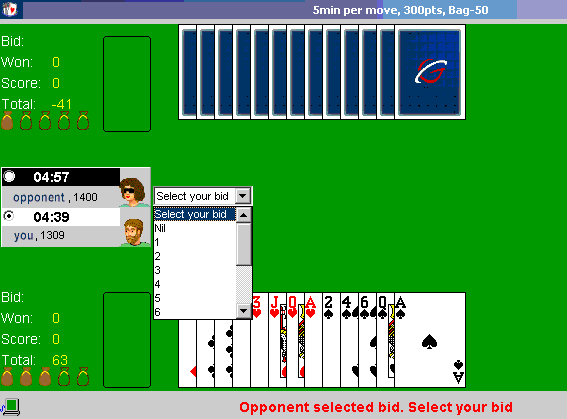|
|
Spades Game Rules
The object of the game is to be the first to score the agreed-upon number of points (default -- 300 points). Points are earned by winning tricks according to bids declared prior to playing. Bidding in Spades After selecting a hand, each spades player needs to select their bid -- an estimate of how many tricks they plan to get during the hand. The picture below illustrates the selection of a bid via a drop-down. In the picture, your cards are shown open on the bottom of the table and your opponent's cards are shown closed at the top of the table. The guiding red message below the table reports that opponent's bid has already been selected. Table options (see details below) on top of the window show default options: 5 min per move, 300 pt total needed and Bag-50 option (-50 pt penalty for 5 bags). The scores in the picture show that "you" have 63 points and 3 used bags (shown in brown) while "opponent" has negative 41 points and 1 bag. 
Playing the Game Non-dealer leads any card except a spade as the first trick. Opponent must follow suit if able; if unable to follow suit, opponent may play any card. A trick that has a spade is won by the highest spade played; if no spade is played, the trick is won by the highest card of the suit led. The winner of each trick leads in the next trick. Spades may not be led until either some player has played a spade (on the lead of another suit), or the leader had nothing except spades left in hand. Playing the first spade is referred to as "breaking" spades. Scoring Each trick bid counts 10 points to a player if the contract is made. Overtricks count one point each. If a player does not make the bid, he/she loses 10 points for each trick bid. Sandbagging rule: Overtricks are often referred to as 'bags'. When you create a table, you can select 'Sandbagging' rule -- it's a default option. Sandbagging comes with the following 3 options: With '-10 for each' sandbagging option for each bag taken, a penalty of 10 points is deducted from the score. Example of sandbagging rule: Player Joe bids 5 tricks. If he wins 7 tricks, he'd score extra 52 points but also lose 20 because of 2 overtricks. Net increase in Joe's score: 32 points. With '-100 for 10' sandbagging option 100 point penalty is applied when the number of overtricks (e.g., over several hands) reaches 10. With '-50 for 5' sandbagging option 50 point penalty is applied when the number of overtricks (e.g., over several hands) reaches 5. Points for tricks: Strategy in Head-to-Head Spades In Head-to-Head Spades you need to achieve three main objectives during the game: (1) get tricks that you bid for (2) prevent your opponent from getting his/her bid (3) give bags to opponent GrandPrix -- World Series of Spades, etc. |
||
|
|
|||
|
|
